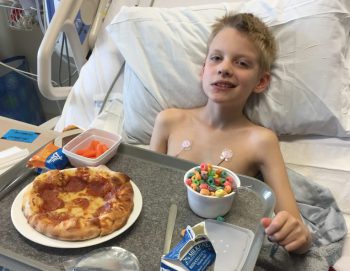
Sometimes it is the simplest of moments that can bring a family with a child in the hospital the most hope. For Tony and Laurie Donati, such a moment occurred when a neurologist at Seattle Children’s Neurosciences Center handed their son Dominic Donati a pen and paper and asked him to write a sentence only days after suffering multiple strokes.
Unable to speak at the time, Dominic, then 9, wrote, “Hi. My name is Dom.”
“It makes me cry every time I think about him writing this incredibly simple sentence,” Laurie, his mom, said. “Dominic’s stroke was the most awful thing that has ever happened to our family. I think everyone in the room felt excited because it was the first time we knew that he could still communicate with us.”
Unexplained headaches lead to 9-1-1 call
The Donatis first suspected something might be wrong when Dominic, the oldest of their three children, began complaining of headaches shortly after starting the fourth grade.
“We sensed he was having more difficulty than normal,” Laurie said. “Our pediatrician initially thought the headaches were likely due to him having a hard time at school, although my motherly instinct said something was really wrong with him.”
One night a few weeks after the headaches started, Dominic awoke in the middle of the night crying. Inconsolable, he slept fitfully for the rest of the night in his parents’ bed. In the morning, Laurie and Tony were bewildered when Dominic couldn’t get out of bed to get ready for school.
“I finally said, ‘Okay Dominic, if you do not get up, I am calling 9-1-1,’ to show how serious this was,” she said. “My heart fell when he still did not move.”
‘You are strong and brave’
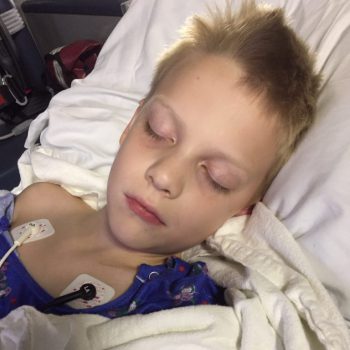
Upon discovering he had no use of his entire right side, Dominic was rushed by ambulance to the Emergency Department at Valley Medical Center. A magnetic resonance imaging (MRI) scan reached a terrifying conclusion – Dominic had experienced multiple strokes.
“As a parent, I feared the worse,” Laurie said. “At the same time, I knew Dominic could hear us even though he was unresponsive. Praying for a miracle, I leaned over and told him, ‘You can absolutely come through this. You are strong and brave.’”
The pediatric neurologist at Valley consulted with Dr. Catherine Amlie-Lefond, director of the Pediatric Vascular Neurology Program at Seattle Children’s Neurosciences Center and a national leader in pediatric stroke. Amlie-Lefond helped guide Dominic’s initial treatment and made arrangements to transfer him to Seattle Children’s for further care.
“We felt so blessed going to a hospital that had a specialty in pediatric stroke- something that, until that day, I did not even know could happen to kids,” Laurie said.
Injured blood vessel causes seven strokes
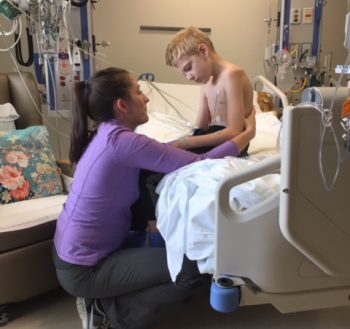
According to the American Stroke Association, strokes occur in about five out of every 100,000 children each year.
“If you think about the thousands of things parents worry about with a child, pediatric stroke does not make that list,” Amlie-Lefond, who leads the only pediatric vascular neurology program in the Pacific Northwest, said.
Unlike adult stroke, pediatric stroke can happen due to a myriad of causes. One of the more common causes of stroke in school-age children is dissection, an injury to a blood vessel supplying blood to the brain. The injured blood vessel begins to make clots, which then travel up into the brain, causing strokes to occur.
After Dominic was admitted to Seattle Children’s Pediatric Intensive Care Unit, further evaluation showed that a dissection caused upwards of seven strokes to occur in three different areas of his brain.
“The doctors told us there was no way we could have prevented what happened to Dominic. It was a freak accident that unfortunately happened to him,” Tony, Dominic’s dad, said. “The best news we got was this was likely just a single incident instead of a bigger problem. His brain would have the opportunity to recover, reroute and create new paths for almost a full recovery. ”
Relearning to walk and talk
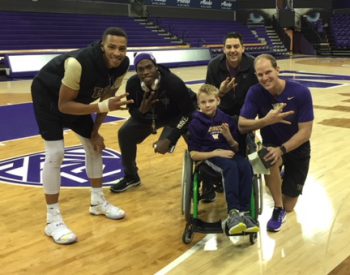
Amlie-Lefond started Dominic on anticoagulation medications to prevent any future clots and allow his body to break down the clot that remained in the artery at the base of his brain. The rest of Dominic’s recovery would be made through intensive rehabilitation to help his brain relearn the functions he lost due to the stroke.
“There’s no such thing as a minor stroke,” Amlie-Lefond said. “It is a huge event when it happens and it can rock a family’s world. The families and children I work with are so special because they always manage to rise to the challenge. Dominic and his family are no exception.”
Working with a team of physical, occupational and speech therapists for several weeks in the inpatient Rehabilitation Unit at the hospital and now, at Seattle Children’s South Clinic, Dominic learned how to walk, talk and do everyday tasks, like getting dressed, all over again. Simple tasks such as grabbing a door knob or squeezing his eyes shut, required his complete concentration in the weeks following his strokes.
“Strokes are exhausting,” Laurie said. “Dominic has worked so hard to get to where he is today. His amazing therapists are always advocating for him to do what is possible.”
Rebounding back to life seven months after pediatric stroke
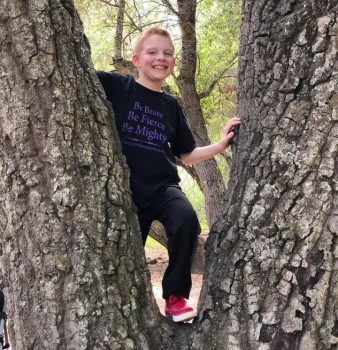
Now 10, Dominic’s growing list of what is possible includes returning to school, rejoining his Cub Scout troop and sinking three pointers on the basketball court during recess.
While the dissection that caused his strokes continues to heal, team sports with potential for contact, like basketball, remain off limits. In the meantime, Dominic has aspirations to join his dad on the sidelines, helping coach his siblings’ youth basketball teams.
“Dominic is really into basketball and he has a knack for coaching,” Tony said. “He is ready to get back into sports, so right now we’re focusing on what he is able to do.”
Even once a child makes their physical recovery from stroke, the experience can forever change a family.
“Restoring their sense of safety, which will never really be the same again, is a big part of helping a family return to health after a stroke,” Amlie-Lefond said. “Every family will experience some setbacks and it is really about supporting them as well as possible as they recover.”
“There are times where we take two steps forward and three back,” Laurie said. “All in all, we are absolutely amazed at his progress and are encouraged every day with his resilience.”
Support from a community of pediatric stroke warriors
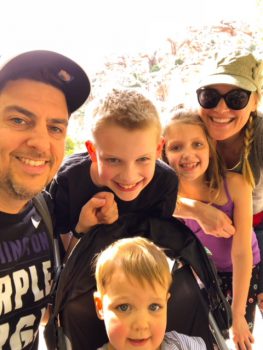
The Donatis have found support in the pediatric stroke community in Seattle. This fall, the family attended a daylong retreat at Camp Korey for families of pediatric brain injury survivors.
Tony and Laurie shared their story at the Pediatric Stroke Warriors Wishes for Warriors Gala with proceeds from the event supporting programs for pediatric stroke survivors, including the Pediatric Stroke Fund at Seattle Children’s.
“Dominic’s strokes have changed us all. We will never be the same. We are closer, we are braver, we are stronger, we are mightier and we love each other fiercer than we ever have before,” Laurie said.

